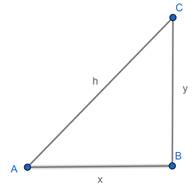Prove that the perimeter of a right-angled triangle of given hypotenuse is maximum when the triangle is isosceles.
Given,
• A right angle triangle.
• Hypotenuse of the given triangle is given.

Let us consider,
• ‘h’ is the hypotenuse of the given triangle.
• ‘x’ and ‘y’ be the base and height of the right angle triangle.
• The hypotenuse of the ΔABC = AC2 = AB2 + BC2
AC = h, AB = x and BC = y
Hence,
h2 = x2 + y2
y2 = h2 – x2
![]() --- (1)
--- (1)
Now, perimeter of the ΔABC is
P = h + x + y
Now substituting (1) in the area of the triangle,
![]() ----- (2)
----- (2)
For finding the maximum/ minimum of given function, we can find it by differentiating it with x and then equating it to zero. This is because if the function f(x) has a maximum/minimum at a point c then f’(c) = 0.
Differentiating the equation (2) with respect to x:
![]()
![]()
![]()
[Since ![]() ]
]
![]() ------ (3)
------ (3)
To find the critical point, we need to equate equation (3) to zero.
![]()
![]()
![]()
[squaring on both sides]
![]()
![]()

![]()
[as the base of the triangle cannot be negative.]
Now to check if this critical point will determine the maximum perimeter of the triangle, we need to check with second differential which needs to be negative.
Consider differentiating the equation (3) with x:
![]()
![]()

[Since ![]() if u and v are two functions of x, then
if u and v are two functions of x, then ![]() ]
]



Now, consider the value of ![]()

As  , so the function A is maximum at
, so the function A is maximum at ![]() .
.
Now substituting ![]() in equation (1):
in equation (1):


As ![]() , the base and height of the triangle are equal, which means that two sides of a right angled triangle are equal,
, the base and height of the triangle are equal, which means that two sides of a right angled triangle are equal,
Hence the given triangle is an isosceles triangle with sides AB and BC equal.